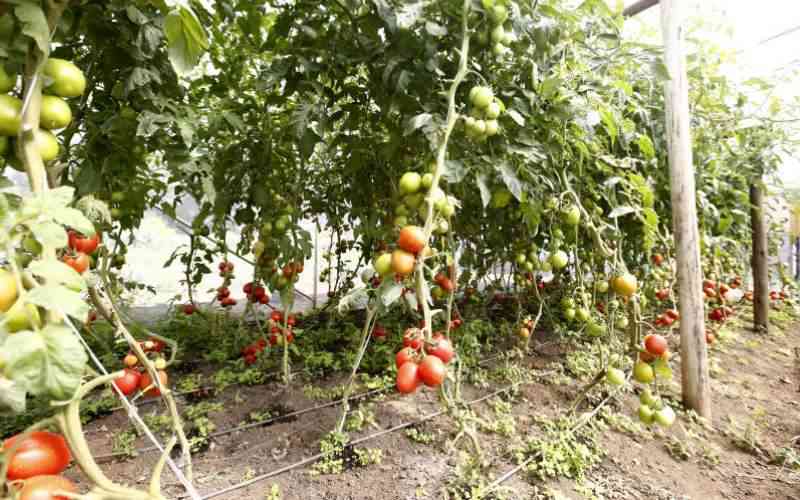
Jared Owino inspecting Tomatoes at one of the green houses at Kenya seed exhibition stand at Nakuru ASK Show. [Kipsang Joseph, Standard]
Tomatoes are relatively easy to grow. But, during the growing period, a lot of challenges occur. To minimise losses, farmers need to take precaution and avoid making mistakes. Here are some of the common mistakes:
Wrong variety choice
Choosing the right variety is the first step towards succeeding. The prime consideration when choosing tomato variety relates to its vegetative growth habit. The next consideration is where you intend to plant your crop. Is it open field or greenhouse? If you are growing tomatoes in a greenhouse, choose from varieties bred specifically for that environment. The warmth and humidity that promote rapid plant growth in a heated greenhouse can also be favourable to fungi, bacteria, and other plant pathogens. If you are growing in the field, choose varieties resistant to the disease pressures known to affect tomatoes in your area.

Healthy tomatoes close up. [Kipsang Joseph, Standard]
Failure to harden tomato seedlings
Hardening enables plant seedlings to adapt to changes in temperature or exposure to harsh weather conditions. Hardening can be done gradually increasing the seedlings exposure to natural weather four weeks before transplanting. If you overlook this stage, the shock of transplantation may stunt or even kill your tomato plants.
Planting tomatoes in wrong places
Although there are plenty of places where you can grow tomatoes, not all are ideal. Consider aspects of climate and soil conditions. Think about sunlight as you pick a spot. Make sure your tomatoes are not in a particularly exposed location or they may be damaged by strong winds. If you are growing in containers, choose containers large enough to accommodate your plants. Make sure, wherever you grow tomatoes, their needs are met. Don't plant them too close to other plants, or to each other. And don't put them far away from the things you will need when tending them. Water and compost/ fertiliser bins should be as close by as possible.

Tomatoes at one of the green house at Kenya seed exhibition stand at Nakuru ASK Show. [Kipsang Joseph, Standard]
Not watering plants properly
Inconsistent watering of plants can lead to calcium deficiency, which causes blossom end rot and fruit splitting. Develop a consistent watering schedule that ensures the plants have enough moisture to sustain growth. Watering is most crucial during the flowering and fruiting stage. But adding too much water at the fruiting stage can cause fruits to split, or increase the risk of tomato disease. It is also a good idea to reduce and even stop watering as the end of the season approaches. This could increase the number of mature fruits you get. Water tomato plants at the base and avoid getting any water on the foliage and fruits. Water resting on foliage can increase the risk of diseases, and sometimes cause scorching in hot sun.
Applying too much nitrogen
Nitrogen application on tomato plants can greatly increase yields. However, too much of it causes plants to put more energy into growing leaves than the fruits. To prevent these issues, use the best fertiliser for tomatoes or opt for natural compost.
Inappropriate or Late Staking
Tomato plant needs staking or trellising to keep them manageable and prevent vigorous tomato varieties from overwhelming other nearby vegetables. Maximise growing space and maintain garden tidiness by training tomatoes to grow up rather than outward, allow for easier harvesting, and to reduce or prevent disease and pest problems caused by tomato fruits and stems resting directly on soil. Install support or trellises when germinating seeds or while seedlings are small. This will help prevent later damage to plants that may be caused by driving stakes through their root systems and when untangling or redirecting mature stems.
 The Standard Group Plc is a multi-media organization with investments in media
platforms spanning newspaper print
operations, television, radio broadcasting, digital and online services. The
Standard Group is recognized as a
leading multi-media house in Kenya with a key influence in matters of national and
international interest.
The Standard Group Plc is a multi-media organization with investments in media
platforms spanning newspaper print
operations, television, radio broadcasting, digital and online services. The
Standard Group is recognized as a
leading multi-media house in Kenya with a key influence in matters of national and
international interest.



